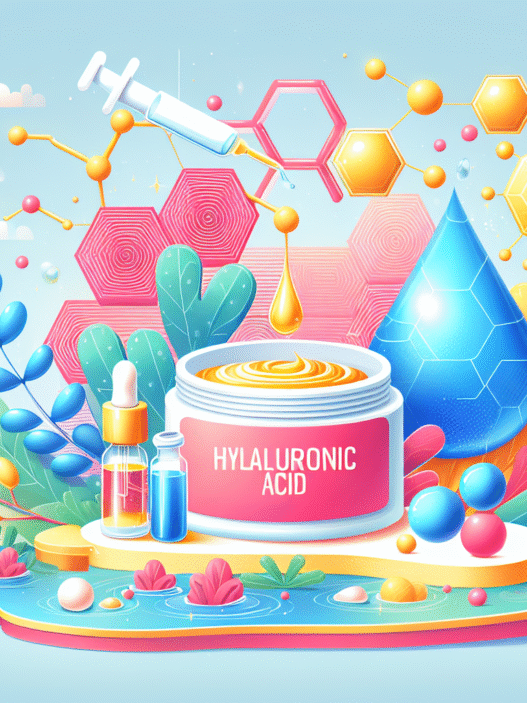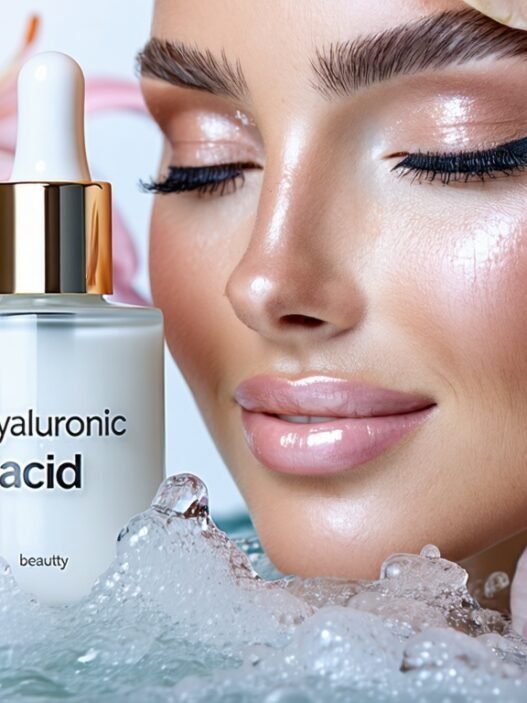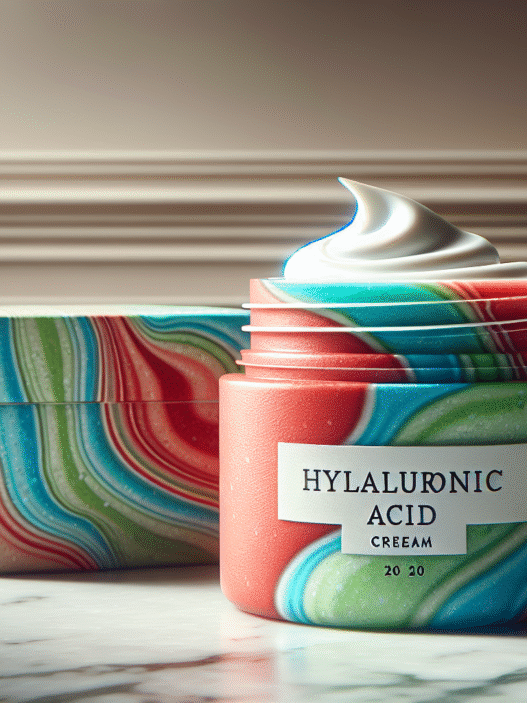Understanding Hyaluronic Acid
Definition and Function
Hyaluronic acid is a naturally occurring substance found throughout the body, particularly in the eyes, joints, and skin. It plays a crucial role in various bodily functions, including hydration and lubrication. Hyaluronic acid helps maintain moisture levels, ensuring that tissues remain plump and resilient. It acts as a cushion for joints and contributes to the overall health of the skin by retaining water.
Additionally, hyaluronic acid aids in transporting molecules throughout the body and serves as a scaffold structure for tissue growth, contributing to processes such as wound healing.
Natural Presence in the Body
The body contains high concentrations of hyaluronic acid, which decreases as individuals age. This decline can lead to dry skin and joint discomfort. Hyaluronic acid is commonly used for skin, joint, and eye health, and it is also a significant focus of research for targeted drug delivery systems.
A table summarizing the areas where hyaluronic acid is naturally present in the body is shown below:
| Body Part | Function |
|---|---|
| Skin | Hydration and elasticity |
| Joints | Lubrication and cushioning |
| Eyes | Moisture retention and lubrication |
Hyaluronic acid is widely regarded as safe for use in over-the-counter products aimed at skin or eye care, as well as in dietary supplements taken orally. Prescription products containing hyaluronic acid should be used according to a healthcare provider’s instructions. For more information on uses and additional benefits, check out our articles on hyaluronic acid benefits and hyaluronic acid injections.
Hyaluronic Acid for Skin Health
Hyaluronic acid (HA) has gained popularity in the beauty industry due to its remarkable benefits for skin health. It is known for enhancing skin hydration and reducing the visible signs of aging. This section highlights the hydration benefits of hyaluronic acid and its anti-aging effects.
Skin Hydration Benefits
Hyaluronic acid is a powerful humectant, which means it has the ability to attract and retain moisture in the skin. A 2021 study indicated that applying topical hyaluronic acid twice daily significantly improved skin hydration and various aspects of skin quality over six weeks.
The following table summarizes the hydration-related benefits of hyaluronic acid:
| Benefit | Description |
|---|---|
| Attracts Moisture | HA can hold up to 1,000 times its weight in water, making it exceptionally effective in keeping the skin hydrated. |
| Improves Skin Flexibility | Enhanced moisture retention improves skin elasticity and makes the skin feel softer and more supple. |
| Enhances Overall Skin Health | By maintaining hydration, HA supports the skin barrier function and helps protect against environmental stressors. |
Anti-aging Effects
Hyaluronic acid not only hydrates but also has significant anti-aging properties. A 2018 review found that various formulations of hyaluronic acid could effectively address skin aging (Medical News Today). Regular application can lead to visible improvements in the appearance of fine lines and wrinkles.
Key anti-aging benefits of hyaluronic acid include:
| Anti-aging Benefit | Description |
|---|---|
| Reduces Fine Lines | HA helps plump the skin, filling in fine lines and giving a smoother appearance. |
| Improves Skin Elasticity | Increased moisture levels contribute to improved skin elasticity, making it less prone to sagging and wrinkles. |
| Enhances Skin Texture | Consistent use of hyaluronic acid can lead to a more refined skin texture, promoting a youthful look. |
Incorporating a hyaluronic acid serum or hyaluronic acid moisturizer into a daily skincare routine can maximize these benefits. For those looking to further enhance their skincare regimen, exploring hyaluronic acid supplements may also be beneficial in improving overall skin condition.
Hyaluronic acid, with its dual ability to hydrate and combat signs of aging, plays a crucial role in achieving youthful and vibrant skin. For more focused improvements on skin elasticity and overall health, consider integrating it into your daily routine.
Hyaluronic Acid for Joint Health
Treatment for Knee Osteoarthritis
Hyaluronic acid has gained recognition as a beneficial treatment for individuals suffering from knee pain due to osteoarthritis (OA). It is commonly administered through injections and acts as a lubricant and shock absorber in the joints. This property helps to alleviate pain and enhances joint functionality, particularly in patients who have previously tried pain relievers and other treatments without success (Mayo Clinic).
The FDA has approved hyaluronic acid injections to relieve knee pain for people with mild to moderate osteoarthritis if other therapies have not been effective (Medical News Today).
| Treatment Approach | Description |
|---|---|
| Hyaluronic Acid Injection | Acts as a lubricant and shock absorber, improving joint movement and reducing pain. Approved for those with mild to moderate OA requiring advanced treatment. |
Efficacy and Safety
A 2022 review analyzing 38 studies indicated that hyaluronic acid injections are generally safe and effective for knee pain relief. While most patients experience positive outcomes, some may encounter mild side effects, such as local swelling and pain for a few days post-treatment.
It is crucial to note that these injections should be performed solely by licensed medical professionals to mitigate any potential complications or risks. Over-the-counter hyaluronic acid products, including serums and supplements, are considered safe for use, but prescription products should be administered as directed by a healthcare provider.
| Safety Considerations | Key Points |
|---|---|
| Administration | Only by licensed medical professionals. |
| Side Effects | Mild local swelling and pain may occur post-injection. |
| Over-the-Counter Products | Generally safe, but should still be used judiciously. |
Understanding the role of hyaluronic acid for joints is essential for individuals dealing with osteoarthritis, as it provides a valuable option for managing knee pain and improving joint health. For further insights on the benefits of hyaluronic acid in skincare and other applications, explore our sections on hyaluronic acid benefits and hyaluronic acid supplements.
Hyaluronic Acid in Beauty Products
Hyaluronic acid is lauded for its remarkable hydrating properties and is a staple ingredient in many beauty products. There are two primary forms of its application: topical treatments and oral supplements.
Topical Application
Hyaluronic acid is extensively used in topical applications, including serums, creams, and hyaluronic acid moisturizers. Its ability to hold approximately one and a half gallons of water makes it exceptional for hydration (Cleveland Clinic). When applied to the skin, it helps to improve moisture retention which can lead to softer and more plump skin appearance.
| Benefits of Topical Hyaluronic Acid | Description |
|---|---|
| Skin Hydration | Provides deep moisture, improving overall skin texture. |
| Soothes Skin | Reduces redness and irritation. |
| Elasticity Improvement | Enhances skin flexibility and softness. |
| Anti-aging Effects | Minimizes fine lines and wrinkles, promoting youthful skin. |
Hyaluronic acid can also be found in specialized products, such as hyaluronic acid cream used for targeted hydration and rejuvenation. Regular use can result in visibly firmer skin.
Oral Supplements
Hyaluronic acid supplements have gained popularity for their internal benefits. Research indicates that doses between 120–240 milligrams per day for at least one month can significantly enhance skin moisture levels and diminish dry skin (Healthline). These supplements are believed to support not only skin hydration but also overall health, aiding in the reduction of fine lines and enhancing the skin’s elasticity.
| Dosage Recommendations | Skin Benefits |
|---|---|
| 120 mg/day | Improved skin moisture and reduced dryness. |
| 240 mg/day | Enhanced hydration effects and further reduction of wrinkles. |
Hyaluronic acid supplements also demonstrate potential beyond skin health, being used in research for easing symptoms of acid reflux. This suggests a broad spectrum of benefits underlining the importance of hyaluronic acid within beauty and health regimes.
For those looking to incorporate this ingredient into their routine, numerous options are available, whether through hyaluronic acid injections for more immediate effects or via supplements and topical formulations for long-term benefits.
Latest Research Findings
Clinical Trials Overview
Recent studies have shed light on the efficacy and safety of hyaluronic acid (HA) for joint health, particularly in treating knee osteoarthritis. A systematic review included thirty-eight randomized control trials (RCTs) focusing on intra-articular injections of HA. Among these, 22 studies (57.9%) were double-blind, indicating a high level of scientific rigor. A total of 5,025 patients with a mean age of 60.28 years participated, primarily suffering from knee osteoarthritis graded 1 to 3.
| Study Type | Number of Studies | Percentage (%) |
|---|---|---|
| Double-blind | 22 | 57.9 |
| Single-blind | 8 | 21 |
| Non-blind | 3 | 7.9 |
| Simple Randomization | 4 | 10 |
| Open-label | 1 | 2.7 |
Future Potential and Areas of Study
The ongoing research has opened various avenues for future studies concerning hyaluronic acid. Current findings suggest that combination formulations of HA with corticosteroids, platelet-rich plasma (PRP), or mesenchymal stem cells (MSCs) yield better results compared to HA used alone for knee osteoarthritis treatment. More investigations are required to explore these combinations, especially with newer molecules such as peptides or diclofenac, aiming for sustained and disease-modifying effects (PubMed Central).
Additionally, studies have demonstrated that a single injection of cross-linked hyaluronate can be as effective as multiple injections of linear high molecular weight hyaluronate in alleviating weight-bearing pain in symptomatic knee osteoarthritis. This finding suggests that the frequency of injections might not be critical to achieving clinical benefits (PubMed Central).
Despite over three decades of successful use of hyaluronic acid in treating knee osteoarthritis, questions remain regarding its safety, optimal dosage, and effectiveness in combination with other treatments. These unresolved issues underscore the need for continued research in this dynamic field.





















